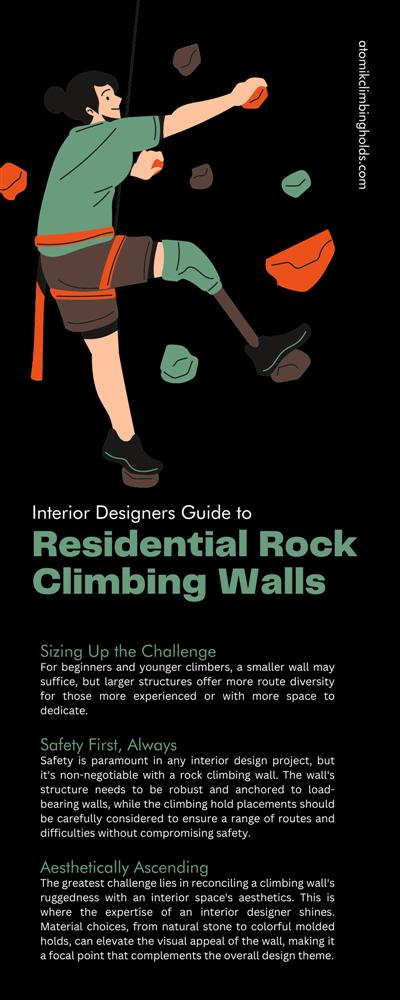A surprising trend is going from the great outdoors straight into the heart of home design—rock climbing walls. Once the exclusive domain of specialty gyms and the most adventurous homeowners, indoor rock walls have become a novel and thoughtful addition to many modern interiors. For the interior designer looking to infuse a space with function and flair, understanding the complexities of incorporating such a dynamic feature is the first step towards creating a home that engages, excites, and challenges its inhabitants.
Here, we'll scale the topic with the precision of a seasoned climber in our guide to residential rock climbing walls for interior designers. We'll explore the benefits, the aesthetics, and the technical considerations of a rock climbing wall for those looking to elevate their space with a bold fitness piece that captures the eye and changes a home's entire design.
The Physical and Social Benefits of Residential Rock Climbing
Before we look at what interior designers must consider, what is it about rock climbing walls that are making them more common amenities in homes everywhere? The allure of rock climbing isn't just about the thrill; it's also about the incredible physical workout and social connection it provides. For fitness lovers, a rock climbing wall offers an excellent full-body workout targeting muscle groups not commonly used in traditional gym exercises.
Conversely, for those who might not consider themselves gym-goers, a climbing wall can provide a less intimidating form of exercise. The wall becomes not just a workout prop but a part of the daily living space, providing a casual means to stay active without the formality of a proper gym visit. It also encourages a family- or community-based approach to fitness, as climbing is easier with a spotter or partner.
Rock Climbing as a Mental Exercise
Mentally, rock climbing is a puzzle and can foster problem-solving skills. Each route presents a new challenge, requiring focus, determination, and spatial awareness. This cognitive engagement and physical exertion make indoor climbing walls more than just a striking feature—they also serve as a tool for personal challenge and growth.
Design Considerations for a Climb-Worthy Space
Incorporating a rock climbing wall into an interior space is not akin to hanging a piece of art or moving a piece of furniture. The significant scale, planning, and safety considerations necessitate a strategic approach that begins with understanding just how the space's aesthetics can seamlessly merge with the wall's functionality.
Sizing Up the Challenge
The first step is determining the size of the wall and the space required. For beginners and younger climbers, a smaller wall may suffice, but larger structures offer more route diversity for those more experienced or with more space to dedicate. The wall should occupy a space that allows for a safe landing zone, offering a cushioned landing surface to prevent injury in the event of a fall.
Safety First, Always
Safety is paramount in any interior design project, but it's non-negotiable with a rock climbing wall. The wall's structure needs to be robust and anchored to load-bearing walls, while the climbing hold placements should be carefully considered to ensure a range of routes and difficulties without compromising safety. The surface material should provide a good grip without being too abrasive on the climber's skin.
Aesthetically Ascending
The greatest challenge lies in reconciling a climbing wall's ruggedness with an interior space's aesthetics. This is where the expertise of an interior designer shines. Material choices, from natural stone to colorful molded holds, can elevate the visual appeal of the wall, making it a focal point that complements the overall design theme.
Many rock wall suppliers offer the same styles and materials for their holds, but not at Atomik Climbing Holds! Our wide inventory of bulk climbing holds includes holds of all different kinds and over 40 colors—an interior designer's dream!
The Holds Every Indoor Rock Wall Needs
If you're new to rock climbing, it may surprise you that not all holds are created equal. Like interior design, there are various styles and types to suit different tastes and purposes. Some commonly found on residential walls include:
- Jugs: Large and easy-to-hold handholds for beginners or warm-up routes.
- Crimps: Small and narrow holds that require precise finger strength.
- Slopers: Rounded and smooth holds that challenge grip and body positioning.
- Pinches: Wide, flat holds that must be gripped with the thumb on one side and fingers on the other.
- Pockets: Small holes to place just fingertips in, requiring grip strength and dexterity.
It's essential to have a mixture of different types of holds on the wall to provide variety and challenge for climbers of all levels.
A Peak into the Future of Residential Design and Climbing Walls
Interior designers must always be at the forefront of trends, and as we've explained in our guide, residential rock climbing walls are more than just a brief fad. Including a rock climbing wall in residential design is a clear indicator of a more adventurous approach to living spaces. It represents the new direction of interior design, which is not just about looks but about creating spaces that reflect the personality and interests of the occupants.
A Trend with Stamina
The trend towards unique, personal fitness spaces in the home has been gaining momentum. Rock climbing walls and other specialty exercise areas speak to the individualized approach many people are taking towards their home environments. They offer a space to pursue interests, hone skills, and engage in activities that resonate with personal values.
The Ultimate Statement Piece
In terms of design, a residential rock climbing wall is the ultimate statement piece. It invites conversation, captivates attention, and can serve as the unique element that ties a room together. When thoughtfully integrated into a space, it becomes more than just a novelty—it's a functional work of art that continually challenges the boundaries of traditional design.
Summiting Your Design Goals
By now, you're likely feeling the pull of possibility that a rock climbing wall brings to residential design. It's a feature no one can overlook, and when executed with care and creativity, it can take room to new heights—both literally and figuratively.
For the homeowner considering this bold addition, take the time to research, plan, and consult with professionals to ensure your climbing wall experience is as enjoyable as it is safe. For the interior designer, remember that the most compelling spaces tell a story, and a rock wall, done right, can be a powerful chapter in the narrative of any home.
Atomik Climbing Holds: Your Route to Indoor Adventure
When selecting your climbing holds for the residential project, every decision is a step towards creating a wall that's truly your own. Atomik Climbing Holds offers a diverse range of options, from textures to colors to sizes and shapes—allowing you to craft a wall that's as individual as you are.
Our commitment to quality, safety, and innovation makes us the premier choice for home enthusiasts and professional climbers. And our turnaround time leaves the competition in the dust, so you get what you need to finish your wall quickly! With Atomik, you can confidently make your wall a masterpiece—a place of exhilaration, growth, and unmatched personal challenge in the comfort of your own home.





Leave your comment